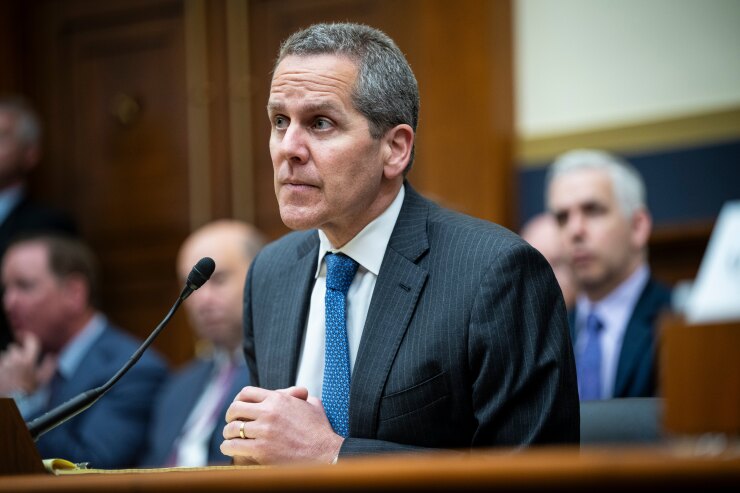
Bloomberg News
WASHINGTON — The Federal Reserve’s Vice Chair for Supervision Michael Barr Monday claimed that regulators are focused on enhancing banks’ liquidity and lengthy-term bank card debt stipulations in purchase to make them extra resilient, however defined tiny regarding the Basel III endgame proposal’s stipulations that might hike main banks’ cash specs.
Speaking on the Federal Reserve Bank of Atlanta’s twenty eighth Yearly Economic Markets Conference, Barr highlighted these three targeted adjustments to the liquidity framework as properly as different actions underway on the Fed to ensure a robust banking supervision framework.
In purchase to bolster banks’ liquidity positions, he suggests the Fed is bearing in mind necessitating massive banking firms to handle a naked minimal quantity of rapidly provided liquidity based mostly on their reliance on uninsured deposits.
“Uninsured deposits usually characterize arduous money needed to satisfy in shut proximity to-time interval needs — like paying out bills or making payroll — and we’ve got seen depositors act promptly to withdraw these assets if their availability is unsure,” he stated. “It is important that uninsured depositors have self worth that their cash will probably be generally on the market, if required, and this self-worth can be elevated by a prerequisite that massive monetary establishments have readily provided liquidity to satisfy requests for these deposits.”
Barr additionally further that as part of this measure, the Fed is pondering of incorporating some obligatory discounted window utilization.
“Incorporating the worth reduce window right into a readiness want would additionally reemphasize that supervisors and examiners view use of the lower cost window as acceptable and unexceptional,” he claimed. “We are in search of recommendations from banks, and this opinions will help us to even additional prioritize operational enhancements.”
Drawing on courses from lender failures in March 2023, the regulator additionally floated the plan of limiting banks’ reliance on held-to-maturity belongings as half of their liquidity buffers — just like the liquidity protection ratio and the interior liquidity fear check out stipulations. He says this might improve steadiness within the course of rigidity illnesses. Held-to-maturity property are usually not very simply convertible to cash with out having vital losses. These sorts of a firesale prompted depositor unease that in the long run led to the unraveling of SVB and Signature monetary establishment remaining 12 months.
Barr additionally suggested recalibrating deposit outflow assumptions for large-net-really value individuals and firms affiliated with enterprise cash or crypto-asset-associated companies to take care of their speedy withdrawal habits observed within the course of present present market nervousness.
“As we noticed within the course of the strain of a 12 months again, these kinds of deposits can flee banking establishments considerably further rapidly than earlier anticipated,” Barr talked about.
Barr stated little in regards to the Basel III endgame proposal’s funds hikes for an important banks, which the Federal Deposit Coverage Corp. estimated at 16% however another analysts have estimated as even larger. Alternatively, Barr touted the proposal’s requirement that midsized monetary establishments additionally consist of unrealized losses as part of their money adequacy assessments, something solely the biggest monetary establishments are presently wanted to do.
“With respect to the acute issues we observed earlier yr, the proposal would additionally lengthen the requirement to copy the results of unrealized losses on cash to all substantial banks,” Barr defined. “This would higher replicate curiosity payment chance in funds, a challenge that carried out an enormous function in each of these SVB’s and 1st Republic’s failures.”
Barr went on to emphasise the worth of loss-absorbing property for monetary establishments in light of earlier 12 months’s banking failures. He claims prolonged-term debt — which regulators can use to recapitalize a bridge financial institution within the wake of a failure — can lower the probability of a monetary establishment function and improve the percentages for orderly decision by producing a failed financial institution way more enticing to possible customers.
Final August, monetary establishment regulatory companies sought basic public responses on a proposal requiring vital banking firms to carry a minimal quantity of extensive-expression bank card debt to soak up losses in circumstance of failure. According to Barr, quite a few feedback supported the proposal’s intent, although some introduced methods that the Fed is now completely analyzing.
The Basel III endgame proposal has been remarkably controversial and deeply opposed by the banking discipline because it was preliminary issued very final July. Fed chair Jerome Powell claimed in March that “broad and supplies” changes can be designed to the remaining Basel proposal, nonetheless irrespective of whether or not the rule is finalized with changes or re-proposed stays unclear.
With conversations nevertheless ongoing amongst members of the Federal Reserve Board and amongst federal companies, Barr stated all policymakers involved want to not solely reinforce the completed Basel rule however the cumulative protection framework all-around monetary establishment security and soundness.
“We are attentive to the interactions throughout these proposals as very effectively because the possible load,” claimed Barr. “Guaranteeing that every particular person of these three components is appropriately calibrated will help to guarantee that banking establishments proceed to be highly effective and able to protect their essential place furnishing credit score rating to U.S. households and firm under a broad vary of issues.”


